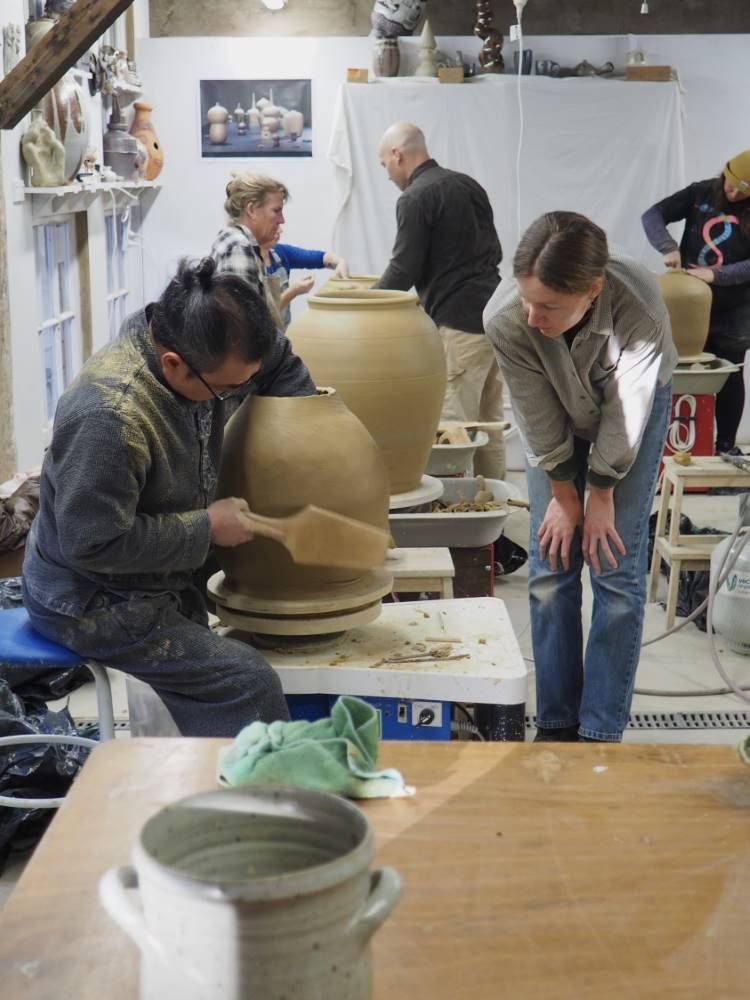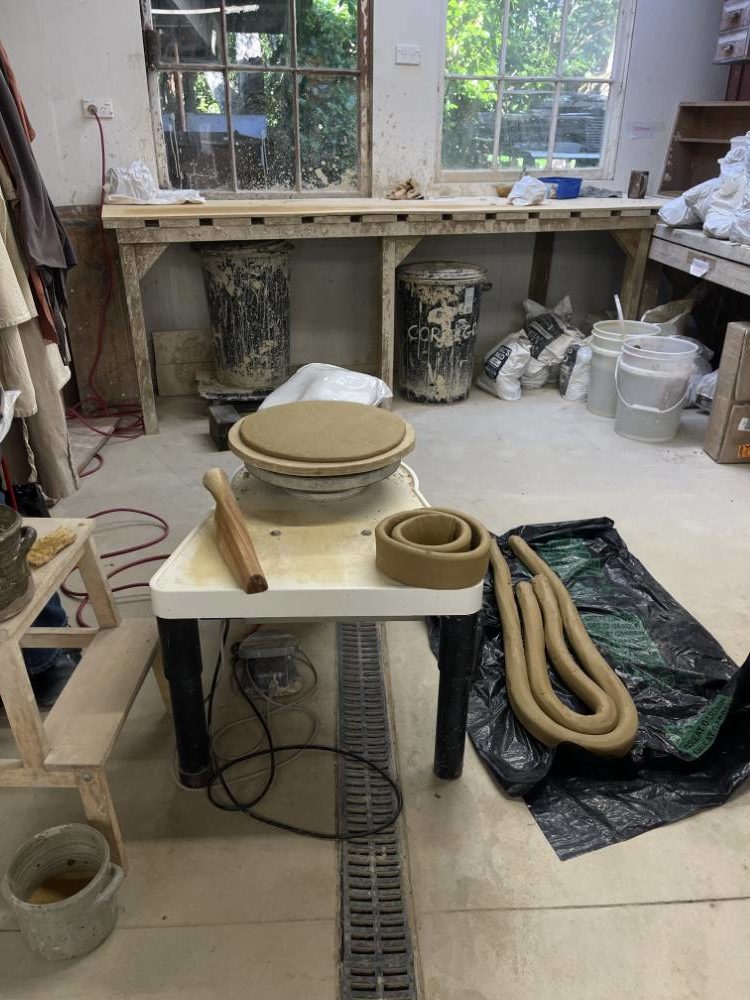By Holly Morgan
Nestled amongst the rolling hills and lush trees in the coromandel, a group of eager clay workers from around the country gathered at the iconic establishment Driving Creek Railway (DCR). Connected by a material, excitement built as we were about to embark on a five day Onggi Masterclass by Korean Master Kwak Kyung Tae & Marco Minetti. The class was nothing short of masterful, filled with eloquent techniques designed to gain an in-depth understanding of the ancient art of making Onggi. My hands are trained in production potting (on the potter's wheel) and each day we were challenged with new interesting skills that by the end of the course we could string together to give us a base level of training to take back to our studios to practice.
Day one, this was spent making very long coils, I particularly found this step quite satisfying. Stretching otherwise solid particles of dirt and water and forming them into 8 sided faceted 'noodles' that we could carry, stack, sling and slide along our hands. Slowly. At the end of the first day, I knew that it was just the beginning and we got a glimpse into the level of detail Kwak and Marco had put into the course. I could tell from the outset that the week was going to be challenging, fun, and inspiring.
Day two, things turned up a notch, our hands really went to the gym and I found myself dreaming about Onggi and waking up at 2am to massage kawakawa balm into my hands. We went on to making our bases, adding our first coils, and were introduced to 'taryeom jil' the art of attaching the coils. It's within this particular technique that I believe holds one of the special charms in making Onggi. When proficient, you have the ability to build forms in a day and manipulate the clay in a way that gives the work structure, height and support with a relative speed. For me, and others when I asked around - this was the most challenging step in the process. I felt very grateful to have been given the opportunity to have it broken down and spelled out. Even so, I felt like my brain couldn't connect to my hands and it wasn't until the last day that I felt a sense of ease. Maybe it was because i'd been beaten into conformity, like the wall of an Onggi pot. Onggi 1 Holly 0.
The following days merged into the melting pot, our guards dropped and with a couple of social evenings cooking pizza under the starry sky, and sharing meals huddled around Barry's Kauri slab table things felt like they were just warming up. We sunk into a rhythm, and the dedication, commitment and focus was unanimous amongst our group of ten. Participants often slipped into class before the day started or skipped half of lunch to head in early to get a couple of extra coils under their belt so to speak. Attaching the coil was a complex yet visually simple motion which involves the slide and movement of both hands working in unison. Squeeze, slide, rotate, up, compress, fill, lock, attach, okay adjust, now the next 1cm. What the videos you see online don't highlight, is the generational knowledge and the sense of feeling and connection with the clay. The material that we are all so familiar with, now being used in a rhythmic dance. I wonder if Kwak ever switches off and allows his mind to wonder?
The final steps of making onggi was to use the su-rae and do-ge to shape and form the jar. When thinking back, getting the hang of this technique was largely about sound as it was how the tools were used. Steady hands grasp hand shaped tools, pop pop pop. The items had been designed by Kwaks teacher and had been soaking in water for a few weeks to add weight. pop pop pop ''Too much power' 'more power' striking a fine balance to create equal amounts of pressure to let the tools bounce and peel off the clay. A seismic meditation. Before long, voluminous bellies emerged each with the motion and essence of the creator or creators in some instances. As someone who feels comfortable exploring large round forms, I've described working away on pieces similar to these as 'therapy pots' so many tiny moments and opportunities for them to take on a life while you're spending time with them. It wasn't all smooth grooves and sunshine, there were moments when you thought that maybe things weren't going too well - and it was amazing to see what a few slaps from your hands on the walls of the vessel could do to improve the shape so you could carry on. Many in the class got to take home a couple of jars by the last day, it was so cool to see the progress. As I'm a slow hands on learner, I took my time and ended up with one larger form which I named 'hand holiday' - mostly because it was not. And to be honest, I snuck off to throw a pot at one point to make sure my hands did still remember what to do. They did - phew!
The whole process had a symbiotic rhythm and movement to it, just like wheel throwing when you get it, you can make it look easy. Fluid tai chi motions when stretching the coils, through to the transfer of energy between you and a lump of earth. It's beautiful, mesmerising and easy to let the world around you slip away. Kwak and Marco were wonderful teachers, Kwaks dedicated approach with humour and delight in the craft accompanied by Marcos' patience, kindness and lightness complimented each other and their approach. They made the participants feel at ease to make mistakes and instilled the confidence to try something completely new and out of their comfort zone. Moreover, aside from our basic Onggi training, we were shown ways for us to see how these new techniques could be used in modern and contemporary ways - re-thinking the way we approach the material. As the dust settles in a pink haze I'm enthused and excited to introduce my new tools to my studio and see what I can do from attending this course. I feel like I've been rewired, and with a small evening practising since the course ended - I can't look at coils in the same way. With the limited time that we did have, I know that the Korean ceramic history is rich and deep - while I know i've only brushed the surface, I do hope to one day make it to Korea to first hand experience Onggi in their homeland and to learn more about this ancient art.


